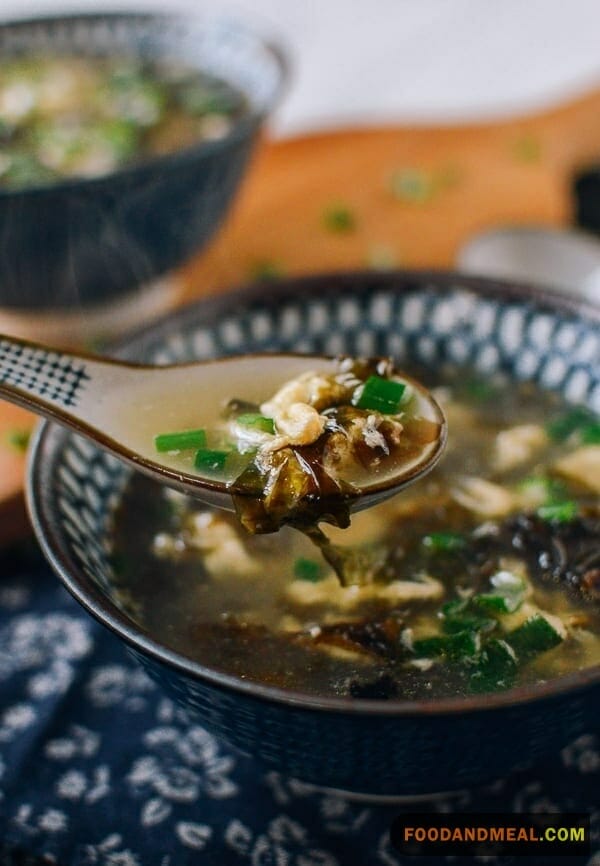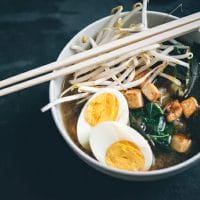Japanese Seaweed Noodle Soup is the ultimate comfort food. This healthy and nutritious dish is full of vitamins and minerals. It can be made vegetarian by adding miso paste. While the nutritional information for this dish may vary slightly from brand to brand, it should still be a tasty option. Read on for more information. It’s easy to make at home! Just add some hot stock to a pot, and then add your noodles. If you’re looking for a little kick, add a dash of lime juice or coriander leaves.
Japanese Seaweed Noodle Soup Recipes


Seaweed Noodle Soup
Ingredients
- 4 green onions chopped
- 3/4 cup snow peas
- 4 tsp. oil canola
- 4 tbsp. miso soybean paste
- 6 cups water filtered
- 7 oz. noodles udon or soba dried
- 4 oz. tofu firm, cubed
- 2 tsp. oil sesame seed
- 1/4 cup low-sodium soy sauce
- 1/2 oz. seaweed dried,
- Wakame
Instructions
- Cook seaweed in small cup of filtered water for five minutes.
- Mix sesame seed oil and soy sauce in shallow dish.
- Cut tofu into 3/4-inch cubes. Add to marinade. Combine well. Allow the mixture to sit at room temperature while you prepare remainder of soup.
- Cook noodles in large sized pot with salted boiling water for about four minutes. Drain. Portion into individual bowls.
- Bring water for broth to boil in sauce pan. Add miso and combine. Remove pan from heat.
- Heat canola oil in separate pan on med. heat. Add cubes of tofu. Saute for three to four minutes and stir occasionally, till golden brown.
- Drain seaweed. Add to serving bowls. Add chopped green onions, tofu and snow peas. Pour in miso broth. Serve.
Video
Notes
Nutrition
© Food And Meal
This website provides approximate nutrition information for convenience and as a courtesy only. Nutrition data is gathered primarily from the Spoonacular Database, whenever available, or otherwise other online calculators.
Alternative Preparation Method: Seaweed Noodle Soup in a Slow Cooker

Ingredients:
- 4-5 sheets of dried seaweed (wakame)
- 200g of udon noodles
- 1 cup of dried shiitake mushrooms
- 1 large carrot, julienned
- 4 cups of vegetable broth
- 3 tablespoons of soy sauce
- 2 tablespoons of mirin
- 1 tablespoon of sesame oil
- 1 tablespoon of miso paste (white or red, as per preference)
- 1 tablespoon of grated fresh ginger
- 2 cloves of garlic, minced
- 2 green onions, finely sliced
- Salt and pepper to taste
- 2 boiled eggs (optional, for garnish)
Instructions:
- Rehydrate the Seaweed: Place the dried seaweed (wakame) sheets in a bowl of water. Let them soak for about 5-10 minutes until they expand and become tender. Once rehydrated, drain and chop the seaweed into bite-sized pieces.
- Prepare Slow Cooker: Start by preheating your slow cooker. Most slow cookers have low and high settings; for this recipe, choose the low setting.
- Combine Ingredients: In the slow cooker, add the rehydrated seaweed, dried shiitake mushrooms, julienned carrots, grated ginger, minced garlic, and sliced green onions. Give them a gentle stir to mix.
- Add Broth and Seasoning: Pour in the vegetable broth, soy sauce, mirin, and sesame oil. These ingredients will form the savory base of your soup. Stir everything together in the slow cooker.
- Cook Slow and Steady: Cover the slow cooker and let the ingredients cook on the low setting for about 4-5 hours. Slow cooking allows the flavors to meld and intensify.
- Boil Udon Noodles: While your slow cooker works its magic, cook the udon noodles separately according to the package instructions. Usually, it takes about 8-10 minutes. Drain and set them aside.
- Miso Paste: About 20-30 minutes before you’re ready to serve, ladle out some of the hot broth from the slow cooker into a bowl. Dissolve the miso paste in the broth and then return the mixture to the slow cooker. This helps to evenly distribute the miso flavor.
- Season and Garnish: Taste the soup and adjust the seasoning with salt and pepper as needed. You can also add a bit more soy sauce or mirin if you prefer.
- Serve: To serve, place a portion of cooked udon noodles in a bowl. Ladle the seaweed and mushroom soup over the noodles. If you like, top with a halved boiled egg and some extra green onions for a beautiful garnish.
- Enjoy: Your slow cooker seaweed noodle soup is ready to be enjoyed. The flavors are deep and comforting, making it a perfect meal on a cold day or whenever you crave a taste of Japan’s seaside comfort.
Tips for making Seaweed Noodle Soup

Cooking Tips
- Rehydrate Seaweed with Care: When using dried seaweed (wakame), be sure to soak it in a bowl of water until it’s tender. Over-soaking can make it slimy, so follow package instructions for the best results.
- Don’t Rush the Slow Cooker: The beauty of a slow cooker lies in its slow and steady cooking. Avoid turning up the heat, as low and slow is key to allowing the flavors to develop fully.
- Customize Seasoning: Adjust the seasoning to your preference. If you like it saltier, add a bit more soy sauce. If you prefer sweetness, adjust the mirin. Taste-testing is your friend.
- Fresh Ingredients Matter: While slow cooking works its magic, use fresh ingredients for garnishing. Fresh green onions, for instance, will provide a vibrant, crisp contrast to the soup.
- Miso at the End: Adding miso paste towards the end of cooking prevents it from losing its delicate flavor. Dissolve it in a bit of hot broth before incorporating it into the slow cooker.
- Experiment with Garnishes: Besides the suggested garnishes, feel free to get creative. Try adding some nori strips, toasted sesame seeds, or a drizzle of chili oil for an extra kick.
Serving Suggestions

- Side of Pickles: A side of Japanese pickles, known as tsukemono, complements the umami flavors of the soup. Options like takuan (pickled daikon) or gari (pickled ginger) are excellent choices.
- Garnish Galore: Be generous with garnishes. Sprinkle with toasted sesame seeds, fresh cilantro, or even a dash of shichimi togarashi (Japanese seven-spice blend) for a flavorful twist.
- Green Tea Pairing: To elevate your meal further, serve it with a cup of Japanese green tea. The subtle bitterness of green tea harmonizes beautifully with the savory soup.
- Cold Beer Match: If you’re looking for a more casual pairing, consider enjoying your Seaweed Noodle Soup with a cold Japanese beer or a glass of crisp sake.
- Light Appetizer: While this soup is hearty, you can serve it as an appetizer before a larger Japanese meal, such as sushi or tempura. It’s an excellent way to start a culinary journey.
Frequently Asked Questions about Seaweed Noodle Soup

- Can I store the leftovers of Seaweed Noodle Soup? Yes, you can store the leftover soup. Allow it to cool to room temperature, then transfer it to an airtight container. Refrigerate for up to 3-4 days. Reheat gently on the stovetop, as high heat can affect the texture of the seaweed.
- Can I use fresh seaweed instead of dried seaweed? While dried seaweed is traditional and imparts a unique flavor, you can use fresh seaweed like spinach or wakame. Just add it towards the end of cooking, as it cooks faster.
- How can I make this soup spicier? If you like some heat, consider adding a pinch of red pepper flakes or drizzling chili oil into the soup when serving. Adjust to your desired level of spiciness.
- Can I make this soup vegan? Absolutely! Simply use vegetable broth instead of chicken or any animal-based broth. Make sure to choose a vegan miso paste as well.
- Is there a gluten-free option for this soup? Yes, for a gluten-free version, ensure you use gluten-free soy sauce or tamari. Confirm that your miso paste is also gluten-free. The rest of the ingredients are naturally gluten-free.
Experience Japanese comfort with Seaweed Noodle Soup. Discover expert tips, delightful garnishes, and have all your questions answered. A warm, savory embrace awaits you.
I'm James F Anderson, a noted sous chef from London and a Le Cordon Bleu alumnus. My career began in a Michelin-starred Parisian eatery, where my blend of classic and contemporary cooking, using seasonal ingredients, earned accolades. Recognized in culinary publications and on cooking shows, I’m committed to mentoring aspiring chefs and delivering memorable dining experiences, marking me as a standout talent in the culinary world.





